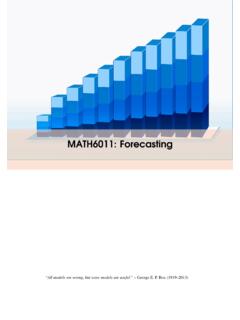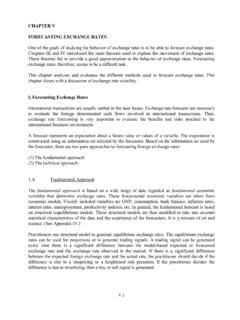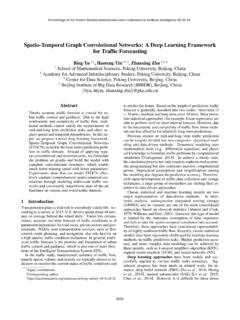Transcription of Abstract - arXiv
1 Convolutional LSTM Network: A Machine LearningApproach for Precipitation NowcastingXingjian Shi Zhourong Chen Hao Wang Dit-Yan YeungDepartment of Computer Science and EngineeringHong Kong University of Science and Wong Wang-chun WooHong Kong ObservatoryHong Kong, goal of precipitation nowcasting is to predict the future rainfall intensity in alocal region over a relatively short period of time. Very few previous studies haveexamined this crucial and challenging weather forecasting problem from the ma-chine learning perspective. In this paper, we formulate precipitation nowcastingas a spatiotemporal sequence forecasting problem in which both the input and theprediction target are spatiotemporal sequences. By extending thefully connectedLSTM(FC-LSTM) to have convolutional structures in both the input-to-state andstate-to-state transitions, we propose theconvolutional LSTM(ConvLSTM) anduse it to build an end-to-end trainable model for the precipitation nowcasting prob-lem.
2 Experiments show that our ConvLSTM network captures spatiotemporalcorrelations better and consistently outperforms FC-LSTM and the state-of-the-art operational ROVER algorithm for precipitation IntroductionNowcasting convective precipitation has long been an important problem in the field of weatherforecasting. The goal of this task is to give precise and timely prediction of rainfall intensity in alocal region over a relatively short period of time ( , 0-6 hours). It is essential for taking suchtimely actions as generating society-level emergency rainfall alerts, producing weather guidance forairports, and seamless integration with a longer-term numerical weather prediction (NWP) the forecasting resolution and time accuracy required are much higher than other traditionalforecasting tasks like weekly average temperature prediction, the precipitation nowcasting problemis quite challenging and has emerged as a hot research topic in the meteorology community [22].
3 Existing methods for precipitation nowcasting can roughly be categorized into two classes [22],namely, NWP based methods and radar echo1extrapolation based methods. For the NWP approach,making predictions at the nowcasting timescale requires a complex and meticulous simulation ofthe physical equations in the atmosphere model . Thus the current state-of-the-art operational pre-cipitation nowcasting systems [19, 6] often adopt the faster and more accurate extrapolation basedmethods. Specifically, some computer vision techniques, especially optical flow based methods,have proven useful for making accurate extrapolation of radar maps [10, 6, 20]. One recent progressalong this path is theReal-time Optical flow by Variational methods for Echoes of Radar(ROVER)1In real-life systems, radar echo maps are often constant altitude plan position indicator (CAPPI) images [9].
4 1 [ ] 19 Sep 2015algorithm [25] proposed by the Hong Kong Observatory (HKO) for itsShort-range Warning ofIntense Rainstorms in Localized System(SWIRLS) [15]. ROVER calculates the optical flow ofconsecutive radar maps using the algorithm in [5] and performs semi-Lagrangian advection [4] onthe flow field, which is assumed to be still, to accomplish the prediction. However, the success ofthese optical flow based methods is limited because the flow estimation step and the radar echo ex-trapolation step are separated and it is challenging to determine the model parameters to give goodprediction technical issues may be addressed by viewing the problem from the machine learning per-spective. In essence, precipitation nowcasting is a spatiotemporal sequence forecasting problemwith the sequence of past radar maps as input and the sequence of a fixed number (usually largerthan 1) of future radar maps as , such learning problems, regardless of their exactapplications, are nontrivial in the first place due to the high dimensionality of the spatiotemporalsequences especially when multi-step predictions have to be made, unless the spatiotemporal struc-ture of the data is captured well by the prediction model .
5 Moreover, building an effective predictionmodel for the radar echo data is even more challenging due to the chaotic nature of the advances in deep learning, especially recurrent neural network (RNN) and long short-termmemory (LSTM) models [12, 11, 7, 8, 23, 13, 18, 21, 26], provide some useful insights on howto tackle this problem. According to the philosophy underlying the deep learning approach, if wehave a reasonable end-to-end model and sufficient data for training it, we are close to solving theproblem. The precipitation nowcasting problem satisfies the data requirement because it is easyto collect a huge amount of radar echo data continuously. What is needed is a suitable model forend-to-end learning. The pioneering LSTM encoder-decoder framework proposed in [23] provides ageneral framework for sequence-to-sequence learning problems by training temporally concatenatedLSTMs, one for the input sequence and another for the output sequence.
6 In [18], it is shown thatprediction of the next video frame and interpolation of intermediate frames can be done by buildingan RNN based language model on the visual words obtained by quantizing the image patches. Theypropose a recurrent convolutional neural network to model the spatial relationships but the modelonly predicts one frame ahead and the size of the convolutional kernel used for state-to-state tran-sition is restricted to 1. Their work is followed up later in [21] which points out the importanceof multi-step prediction in learning useful representations. They build an LSTM encoder-decoder-predictor model which reconstructs the input sequence and predicts the future sequence simultane-ously. Although their method can also be used to solve our spatiotemporal sequence forecastingproblem, thefully connected LSTM(FC-LSTM) layer adopted by their model does not take spatialcorrelation into this paper, we propose a novelconvolutional LSTM(ConvLSTM) network for precipitation now-casting.
7 We formulate precipitation nowcasting as a spatiotemporal sequence forecasting problemthat can be solved under the general sequence-to-sequence learning framework proposed in [23]. Inorder to model well the spatiotemporal relationships, we extend the idea of FC-LSTM to ConvLSTM which has convolutional structures in both the input-to-state and state-to-state transitions. By stack-ing multiple ConvLSTM layers and forming an encoding- forecasting structure, we can build anend-to-end trainable model for precipitation nowcasting. For evaluation , we have created a newreal-life radar echo dataset which can facilitate further research especially on devising machinelearning algorithms for the problem. When evaluated on a synthetic Moving-MNIST dataset [21]and the radar echo dataset, our ConvLSTM model consistently outperforms both the FC-LSTM andthe state-of-the-art operational ROVER Formulation of Precipitation Nowcasting ProblemThe goal of precipitation nowcasting is to use the previously observed radar echo sequence to fore-cast a fixed length of the future radar maps in a local region ( , Hong Kong, New York, or Tokyo).
8 In real applications, the radar maps are usually taken from the weather radar every 6-10 minutes andnowcasting is done for the following 1-6 hours, , to predict the 6-60 frames ahead. From the ma-2It is worth noting that our precipitation nowcasting problem is different from the one studied in [14], whichaims at predicting only the central region of just the next learning perspective, this problem can be regarded as a spatiotemporal sequence we observe a dynamical system over a spatial region represented by anM Ngrid whichconsists ofMrows andNcolumns. Inside each cell in the grid, there arePmeasurements whichvary over time. Thus, the observation at any time can be represented by a tensorX RP M N,whereRdenotes the domain of the observed features. If we record the observations periodically, wewill get a sequence of tensors X1, X2.
9 , Xt. The spatiotemporal sequence forecasting problem isto predict the most likely length-Ksequence in the future given the previousJobservations whichinclude the current one: Xt+1,.., Xt+K= arg maxXt+1,..,Xt+Kp(Xt+1,..,Xt+K| Xt J+1, Xt J+2,.., Xt)(1)For precipitation nowcasting, the observation at every timestamp is a 2D radar echo map. If wedivide the map into tiled non-overlapping patches and view the pixels inside a patch as its measure-ments (see Fig. 1), the nowcasting problem naturally becomes a spatiotemporal sequence note that our spatiotemporal sequence forecasting problem is different from the one-step timeseries forecasting problem because the prediction target of our problem is a sequence which containsboth spatial and temporal structures. Although the number of free variables in a length-Ksequencecan be up toO(MKNKPK), in practice we may exploit the structure of the space of possiblepredictions to reduce the dimensionality and hence make the problem Long Short-Term Memory for Sequence ModelingFor general-purpose sequence modeling, LSTM as a special RNN structure has proven stable andpowerful for modeling long-range dependencies in various previous studies [12, 11, 17, 23].
10 Themajor innovation of LSTM is its memory cellctwhich essentially acts as an accumulator of thestate information. The cell is accessed, written and cleared by several self-parameterized controllinggates. Every time a new input comes, its information will be accumulated to the cell if the input gateitis activated. Also, the past cell statusct 1could be forgotten in this process if the forget gateftis on. Whether the latest cell outputctwill be propagated to the final statehtis further controlledby the output gateot. One advantage of using the memory cell and gates to control information flowis that the gradient will be trapped in the cell (also known as constant error carousels [12]) and beprevented from vanishing too quickly, which is a critical problem for the vanilla RNN model [12,17, 2].
![arXiv:1301.3781v3 [cs.CL] 7 Sep 2013](/cache/preview/4/d/5/0/4/3/4/0/thumb-4d504340120163c0bdf3f4678d8d217f.jpg)
![arXiv:0706.3639v1 [cs.AI] 25 Jun 2007](/cache/preview/4/1/3/9/3/1/4/b/thumb-4139314b93ef86b7b4c2d05ebcc88e46.jpg)

![@google.com arXiv:1609.03499v2 [cs.SD] 19 Sep 2016](/cache/preview/c/3/4/9/4/6/9/b/thumb-c349469b499107d21e221f2ac908f8b2.jpg)













